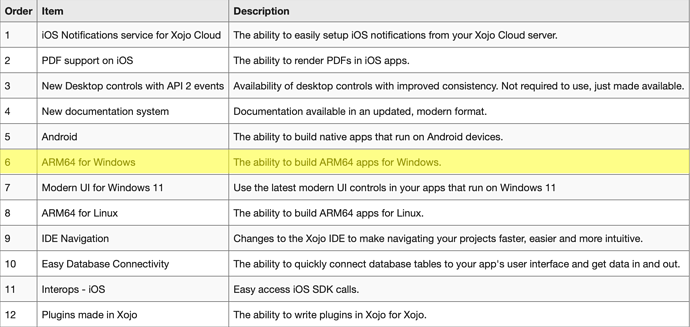Thank you Ivan. Sometime I feel like I’m crazy. This explains a lot.
Hybrid x64 Apps for Windows ARM (Mix native ARM and X64 legacy)
Nice reaction.
Works for me!
t’s no cost to add it there. I add if days ago (if I were in charge).
With lack of clearness, it’s logical to be confused and to expect what we need.
I know no one is asking, but if I were the product manager on this, my priorities for new revenue would be:
- Android
- Documentation
- ARM64 period!
- IDE Improvements
Those four items would bring new users in, be sure that they could use the product successfully, recognize the full level of cross-platform development possibility, and not get frustrated by issues in the IDE.
As for Windows 11 Look-and-feel updates, that should be a given.
Everything else is “important for sustaining existing users”.
If Xojo were properly unleashed on the Android base - whoa!
You have to know the market to have priorities in the right place. For Android to bring lots of new users to Xojo, they should have released 10 years ago. Currently there are other tools that can do Android using a Basic dialec, that are free and much more feature rich. Android is not going to bring many new users, it is actually on the side of “sustaining existing users” that also want Android.
If Xojo at least had support for Single codebase to deploy anyware… Yes, in that case they could have a HUGE new users potential, but that is not the case.
Don’t make assumptions about what others know or don’t know.
I would love to be introduced to a single one of these that provides the low learning curve and RAD capabilities that Xojo offers.
My vision for a global market access scope, the current one has a much smaller niche priority focus:
| Order | Item | Description |
|---|---|---|
| 1 | New Desktop controls with API 2 events | Availability of desktop controls with improved consistency. Not required to use, just made available. |
| 2 | New documentation system | Documentation available in an updated, modern format. |
| 3 | Android | The ability to build native apps that run on Android devices. |
| 4 | ARM64 for Windows | The ability to build ARM64 apps for Windows. |
| 5 | Modern UI for Windows 11 | Use the latest modern UI controls in your apps that run on Windows 11 |
| 6 | ARM64 for Linux | The ability to build ARM64 apps for Linux. |
| 7 | IDE Navigation | Changes to the Xojo IDE to make navigating your projects faster, easier and more intuitive. |
| 8 | Easy Database Connectivity | The ability to quickly connect database tables to your app’s user interface and get data in and out. |
| 9 | iOS Notifications service for Xojo Cloud | The ability to easily setup iOS notifications from your Xojo Cloud server. |
| 10 | PDF support on iOS | The ability to render PDFs in iOS apps. |
| 11 | Interops - iOS | Easy access iOS SDK calls. |
| 12 | Plugins made in Xojo | The ability to write plugins in Xojo for Xojo. |
You know what the Xojo Android will do wrong (for me at least) from the start? Not being prepared for multiple layouts of multiple sizes, targets. If I do recall correctly, it will lack my preferred target: Tablets in landscape mode. Phones are for companion apps for me, my main target are tablet apps. As many business focused devs are.
I also miss so much:
| Order | Item | Description |
|---|---|---|
| 13 | Layout zooming | Availability to zoom in and out and pan the contents on the layout editor and its window. Zoom out or zoom in and pan, then go to the normal scale on an target region/component to be edited is enough. |
They certainly would have had a lot more success a decade ago, but yet, there are enough Xojo users who may want to port their existing apps to Android. With API 2.00, it should be a lot easier than to have to port under another Basic (which I did years ago. Not trivial).
That is what I said, those are not NEW users.
I hate to rain on your parade, but for the record, Xojo never provided any built-in way to obtain vibrancy for Mac, although it came with Yosemite, back in 2014.
Since Windows 11 translucency after all is pretty much the same kind of effect, it would seem surprising that Xojo implemented it more than vibrancy under macOS. Incidentally, translucency was first implemented in the infamous Vista, back in 2006. It does not make me any younger ![]()
Yet, they would be new to the platform ![]()
I didn’t say that it “was” a given, but that it “should be” a given. We’ve all witnessed RB/RS/Xojo’s after the fact responses to these high-level OS changes.
It should indeed, and yet, Xojo neglected to do anything when Yosemite came to be. If it was not for Sam Rowlands who provided declares, vibrancy would have been unknown on Xojo. I strongly feel that will be the same for Windows translucency.
Definitely not disagreeing with you.
